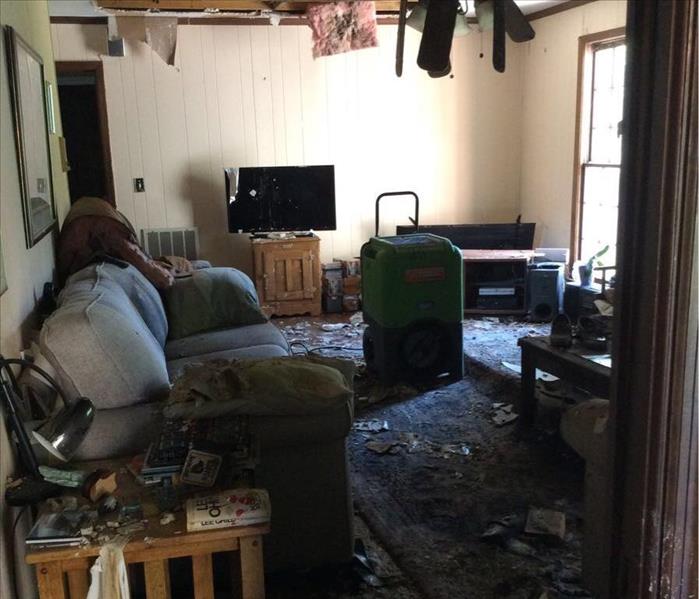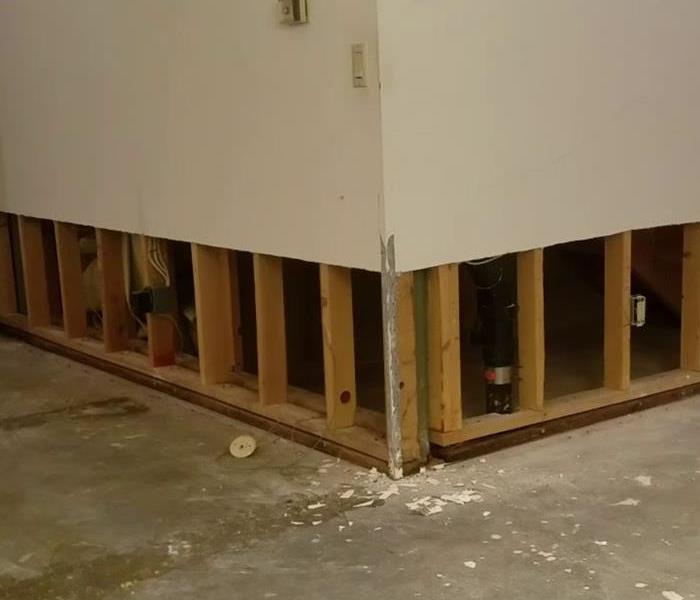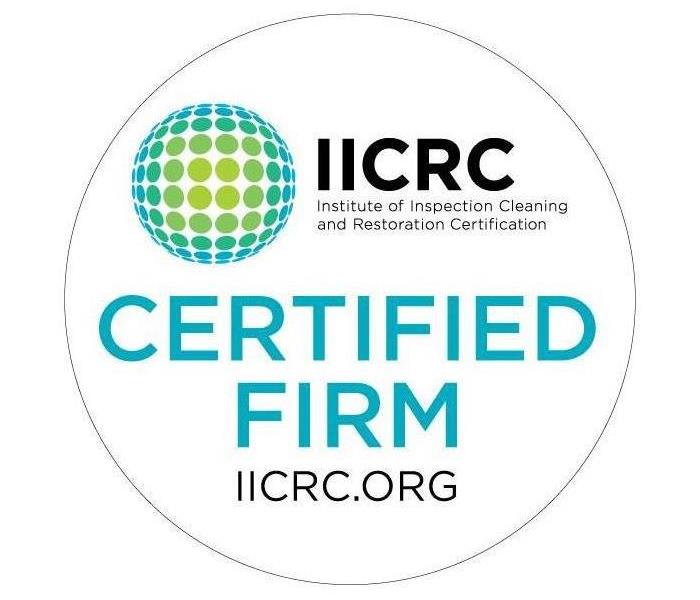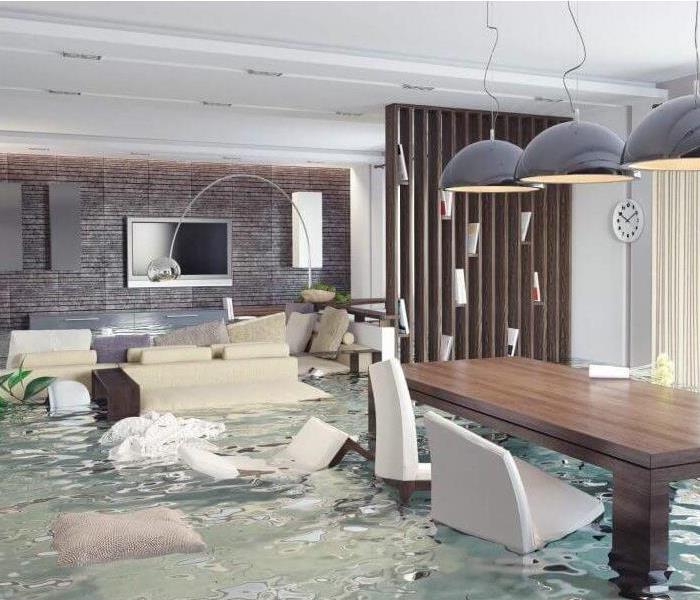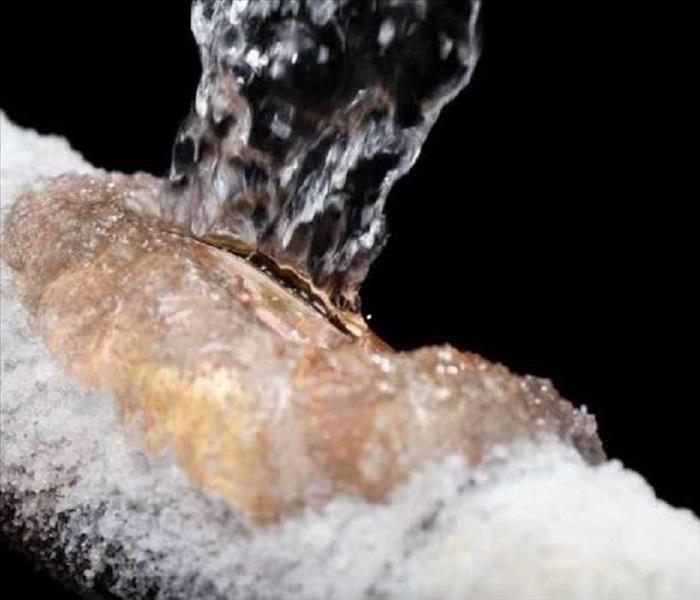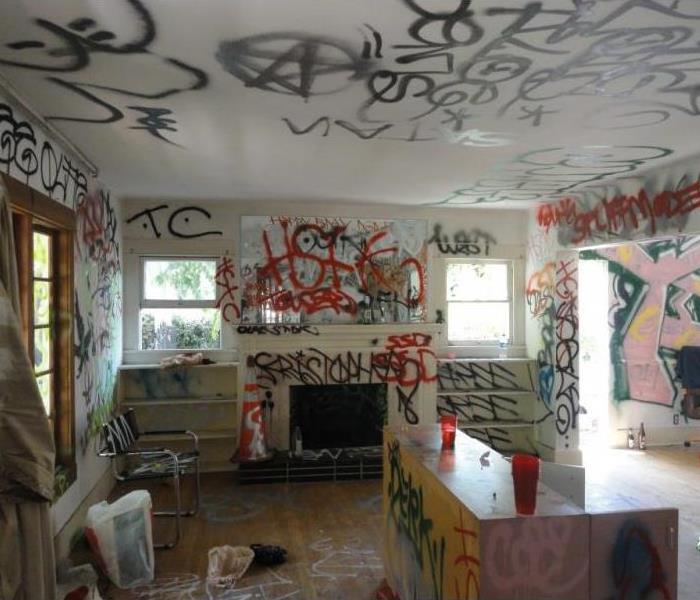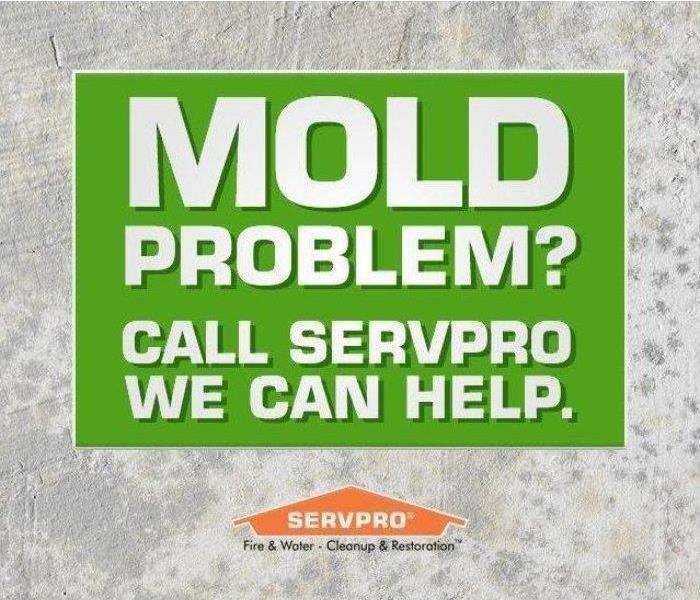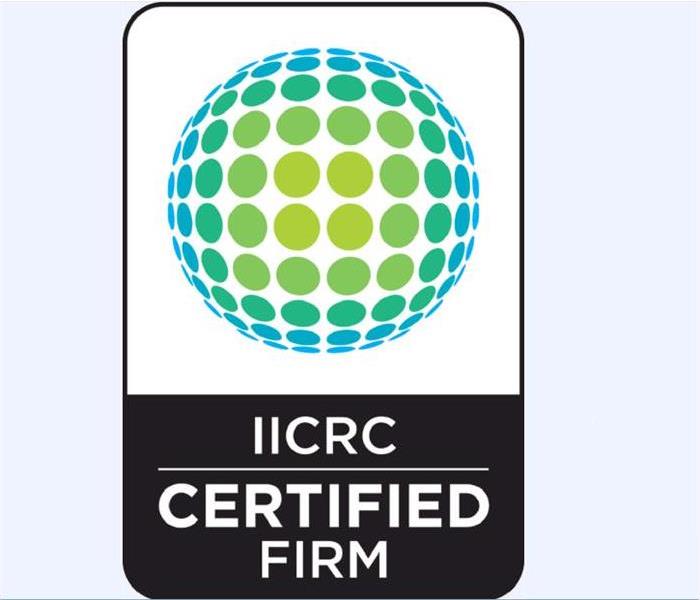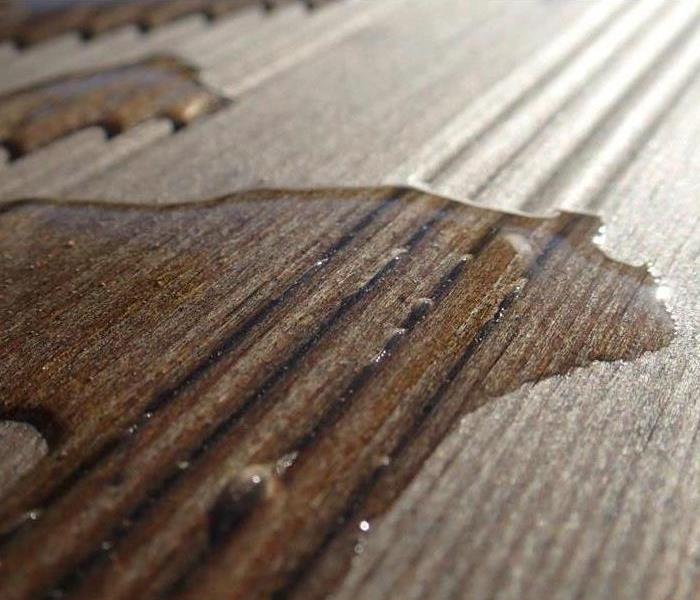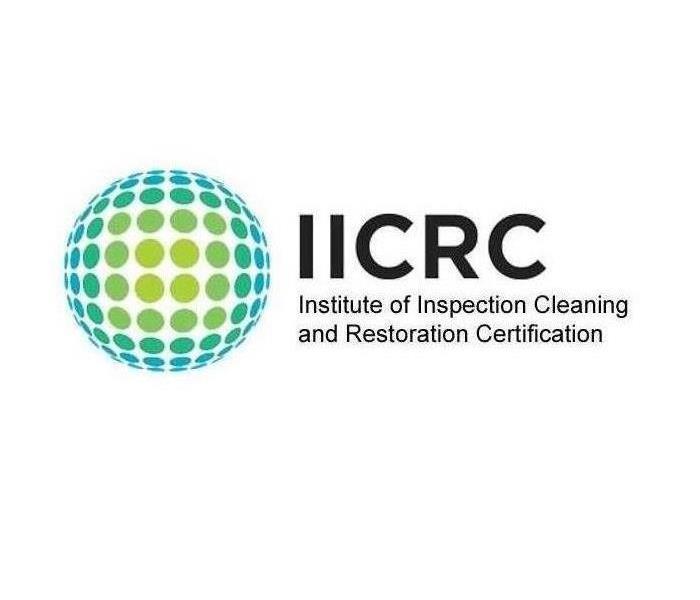Archived Water Damage Blog Posts
Autumn Warnings for Storm or Flood
9/12/2022 (Permalink)
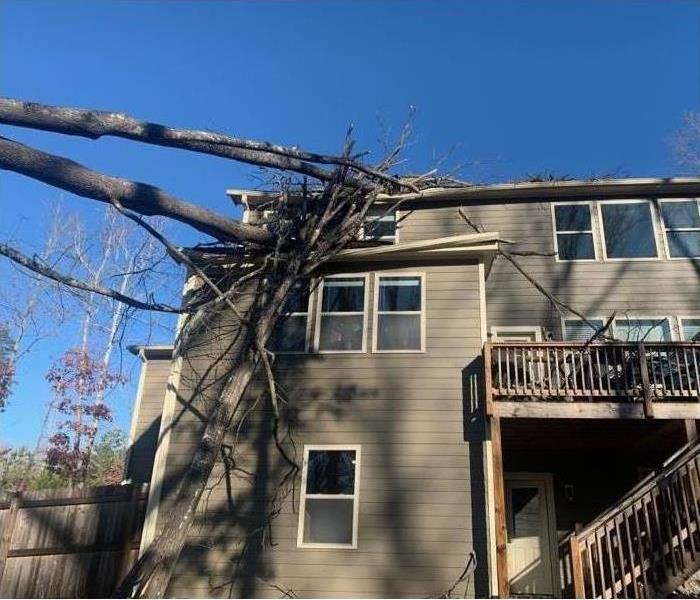 tree damage after storm
tree damage after storm
With the changing seasons comes changing temperatures and weather patterns. Storms can become more frequent and with it, floods and flash floods. Floods can be dangerous for homes, businesses, and traffic of all kinds. It's best to know what to do in case of a flood or major storm.
- Always have a plan ready in case a storm or flood happens. Not only for your home, but in case you are caught out in a vehicle or as a pedestrian. Know what to do to keep your loved ones and pets safe.
- Know the risks for floods and storms in your area. Web sites such as FEMA.gov, NOAA.gov, and weather sites are good sources to know when to expect the possibility of storms and floods and potential water damage.
- Make sure you have adequate insurance coverage for your home and vehicle that covers flood and water damages.
- Keep important documents in a waterproof container so they aren't damaged.
- Keep your home in good repair to avoid leaks and storm damage as much as possible.
In the event of a flood, storm (particularly a hurricane and you are on the coast), or other such emergency, always:
- Follow the instructions of emergency personnel. If you are ordered to evacuate - then evacuate! Have a plan ready and materials to board up your home if needed. Don't wait until the last minute as you may get caught in traffic. Although here in the Columbia area we aren't as affected as the coast in a hurricane, we can still get nasty storms that can bring floods and excess water.
- Know what to do if you are caught in a storm or flood while in a vehicle. Never try to drive through moving water, or even still water. It is not easy to tell how deep the water is and a vehicle can easily be swept away and pose a drowning hazard.
- Never try to walk or swim through moving water. Not only can it be stronger than your ability to move through it, you may not know what hazards are in that water. There could be moving debris as well as microorganisms that could pose a health hazard.
- Be aware of other hazards in water such as snakes, animals, or electrocution due to exposed wires or downed power lines.
- If you are trapped, try to get to high ground (roof, top of vehicle, etc.) and wave a bright, colorful cloth or flashlight to attract the attention of emergency services.
If your home is damaged by a flood or storm, be sure to call us here at SERVPRO for professional assistance in assessing and mitigating the damage and getting you back into your home as soon as possible.
9 Ways To Avoid Water Damage
4/4/2022 (Permalink)
You may be surprised to know that water damage is one of the most common – and costly damages to homeowners.
Throughout the United States water damage is the second most costly event, preceded by wind and hail damage. You may experience hail or severe winds a few times a year, water damage is a year-round risk.
The great news is that there are ways to protect yourself from costly water losses. We have nine simple steps to help keep your home safe and well-maintained and most importantly to reduce your risk of water damage.
Outside your home
- Disconnect hoses
The first thing on your fall-to-do list should be to disconnect your hoses from the faucet. Standing water in your hoses can freeze back into the pipe and create an ice block that stops the water flow and may bust the pipes to create damage to walls, floor and foundation.
- Keep gutters and downspouts clean
At least twice a year you should clean your gutters to avoid blockage and ice dams. Standing water can cause damage to your gutters and roof and unmanaged overflow can create puddles that can damage your foundation. Always be sure to clean any downspouts to ensure water can flow through secure all downspouts to ensure that they point away from your foundation.
- Maintain vegetation and trees
Growing shrubs can be a great addition to the beauty of your home – except when their roots wrap around your pipes and break them. Be sure to minimize landscaping near your utility pipes or if necessary, remove trees and shrubs that have become too large.
Inside your home
Now that we gone over a few simple steps for outside your home, let’s look at how to keep the risk from water damage from sources inside your house.
- Know where your main water valve is
Most plumbing experts will tell you that the main water shutoff valve may be the most important plumbing feature in your entire home. That’s because your main water valve supplies water to your entire home. Water enters your home through the main water valve and is then distributed to other pipes throughout your home.
If you ever experience a plumbing emergency inside your home, knowing where your main water valve is located will make it easier to turn off your water right away, and most likely minimize any further damages.
It is also recommended that you shut off your main water valve if you leave your home for an extended period. Chances are if no water is going into the home, no damages will occur.
- Appliance Maintenance
The most common cause of in-home water damages are your appliances. Be sure to check and maintain your appliances regularly for leaks according to the manufacturer’s manual.
It is recommended that you pay close special attention to your washing machine and refrigerator hoses. These tend to become old within about five years of install and they tend to become brittle and often become leaky as well, and these are the most frequent and common cause of water damage to most homes. Replace yours regularly to avoid a HUGE mess and costly damages.
- Investigate and fix leaks ASAP
If you see evidence of a leak anywhere in your home, investigate it ASAP. If you choose to ignore moisture or postpone making proper repairs, be prepared to smell mold, mildew and experience dry rot, or even structural damage to your home.
Most homeowner’s insurance only covers sudden and accidental damages. If the damage results from lack of maintenance, it may not be covered on your standard homeowner’s policy.
- Install multiple water detection devices
A water detector is a small electronic device that sounds an alarm if the sensor comes in contact with moisture. The main benefit is that it can detect low moisture levels or slow leaks that can often go unnoticed. You can install this device near water heaters, sump pumps, washing machines, dishwashers, and toilets. If there is a pipe that has water coming out of it, you can put one there to prevent extensive damage and mold growth.
- Check the water pressure into your home
If the water pressure in your home is set too high, your pipes and hoses could fail under the pressure.
Typically, the residential water systems are designed for water pressure of 40 – 70 psi. If your home’s water pressure goes over 100 psi, you need to install a pressure regulator (available at most hardware stores.)
- Keep an eye on your water bill
Frequently, the only way to know that there is a water leak taking place, is a closer look at your water bill. Your usage could jump sky high from the previous month’s bill without explanation, be sure to investigate. There could be a leak in your crawlspace or a pipe in your front or back yard.
Best practice is not to leave a mystery leak unattended. If you do find a leak that has caused water damage to your home. Give SERVPRO of The Dutch Fork a call and we can help you 24 hours a day, 7 days a week. We will make it "Like it never even happened."
Burst Pipes? Let Us Help
1/10/2022 (Permalink)
Colder temperatures are slowly creeping in the Dutch Fork area, as these numbers reach overnight lows below freezing you could experience bursting pipes. You may inspect your commercial property on a regular basis, but sometimes bursting pipes still occur. If you experience water damage, as the result of a damaged pipe, time is not on your side. You want to get it fixed quickly so that you can avoid as much damage as possible. Here are some tips to help you prepare for what’s ahead:
Do You Need a Professional?
As soon as you’ve noticed or located damage, you may want to call plumbing experts to fix the broken pipe. The representative who answers the phone will likely ask you a few questions to determine what kind of problem you have, and dispatch assistance.
Assessing the Damage
Bursting pipes are as critical as they sound. Water is likely spewing in all directions, soaking everything in its path. Once the water has been turned off, gather as much information as you safely can.
Contact Mitigation Experts
Contact your local SERVPRO Franchise. They’ll take your contact information and send a team to help you ASAP.
Water Extraction
If your preliminary report over the phone was accurate, it will likely match the professional assessment pretty closely. This means the technicians can get right to the water extraction. They pump the water out to halt its potential to cause secondary damage.
Surface Drying
It's not enough to just remove the standing water. Everything must be dried, or your building is likely to develop a mold problem. This is particularly probable if the leak has significantly raised the humidity of the area.
All of these things ideally happen within the first 24 hours; mold can start to grow in as little as a day. The sooner you call the problem with your bursting pipes in and get the repair process started, the better chance you have of avoiding secondary damage.
National Preparedness Month: Week Two
9/3/2021 (Permalink)
Week Two of National Emergency Preparedness Month
The second week of National Preparedness Month is dedicated to another crucial step to ensure your family or household is ready for an emergency or disastrous situation: Building an emergency kit. Putting together an Emergency Kit is simple and only takes a little planning. Some items to include:
- Water (one gallon per person per day, for several days)
- Food (at least a three-day supply of non-perishable items)
- Battery or hand-crank powered radio with a NOAA Weather Radio
- Flashlight & extra batteries
- First aid kit
- Whistle (to signal for help)
- Dust mask
- Plastic sheeting and duct tape (to shelter in place)
- Moist towelettes, garbage bags and plastic ties (for personal sanitation)
- Wrench or pliers (to turn off utilities – preventing additional water damage)
- Manual can opener
- Local maps
- Cell phone with chargers and a backup battery
- Medications (prescription & generic illness/ailments)
- Infant formula, bottles, diapers, wipes & creams
- Pet food & water for pets
- Cash or traveler’s checks
- Important documents – copies of insurance policies, ID Cards, Bank records
- Sleeping bag or warm blanket for each person
- Changes of clothes
- Fire extinguisher
- Matches in waterproof container
- Feminine supplies and personal hygiene items
- Paper and pencil
- Books, games, puzzles, or other activities for children
https://www.ready.gov/kit
National Preparedness Month: Week One
9/2/2021 (Permalink)
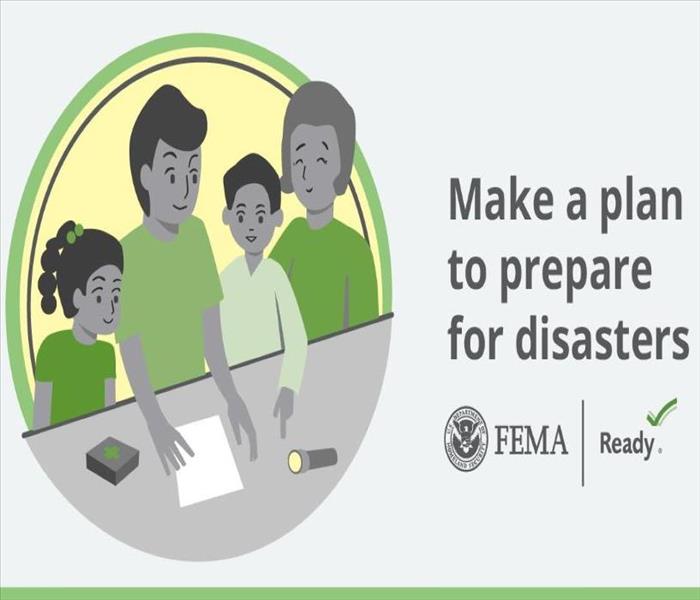 Create a plan for your household to prepare for South Carolina Disasters
Create a plan for your household to prepare for South Carolina Disasters
September is National Preparedness Month
This week we’re highlighting the importance of planning. The first step to ensuring you and your loved ones are prepared for any emergency that may arise in the South Carolina area, is to create a feasible plan. This plan should cover everything from being alerted to disaster, to financial recovery should it be necessary. Set aside time to run through various scenarios and create a list of items that your family/household cannot go without (water, non-perishable food, medications, and pet supplies). Include all family/household members in the planning process so everyone is familiar with the plan, in the event you’re not all together, everyone knows the same information.
Ready.gov put together a great resource to help guide you in your planning phase. Be sure to check it out!
https://www.ready.gov/plan
Leaving Town? Turn Off That Water!
7/8/2021 (Permalink)
We recently received a call from a homeowner that returned from vacation to find their home in disarray. Ceilings had fallen, drywall crumbled, and most of their belongings were soaking wet! At some point during their trip, there was a plumbing issue that caused water to back up and flooded the inside of the home, causing major damage.
When we arrived on-site to start removing the standing water and non-salvageable materials, we were given the opportunity to share a teaching moment. Had this family been home, they likely could have avoided the extent of damage that they are now facing. We showed them the location of their water shut-off point or valve, which stops all water from flowing into the home. Turning off the water until a plumber can address your issues helps to minimize damage and keep the affected areas to a minimum. Saving yourself money and limiting the overall damage.
If you plan to leave your home unattended for longer than a few hours, even if it is just a weekend trip, we advise turning off the water to your home! Returning to a swimming pool in your living room is not what you want to come home to.
Water Heater Burst? We Can Help!
6/23/2021 (Permalink)
Next to plumbing, water heaters are one of the most common sources of water damage in a home. They are not usually placed in highly visible areas, which makes forgetting about them and their maintenance, easy to do. A water heater can cause serious water damage, fast. They contain large amounts of water, but they are also connected to supply lines that fill rooms with water very quickly.
It’s important to maintain any system in your home, and much like your HVAC unit that gets a routine checkup or cleaning, do the same for your hot water source! While they do have a significant life span, it’s not the most wise choice to push it to its’ limits.
If you have discovered your water heater leaking, or walked into a puddle of water:
- Turn the Supply Off
- Locate the cold-water supply pipe, turn the valve clockwise until it is closed. This turns off the supply to the tank.
- Shut off Power
- An electric or gas heating element can stay heated long after the water has escaped the tank. Wasting energy and posing a fire hazard. Locate your breaker box and turn the power off completely.
- Cleanup
- Remove any undamaged furniture, rugs and salvageable belongings. They’re dry and you’d like for them to stay that way!
- Call SERVPRO!
- We’ll help you walk through an insurance claim, the mitigation process and any necessary repairs to make your home “Like it never even happened.”
Water Damage Help When You Need It Most!
2/12/2021 (Permalink)
At SERVPRO of The Dutch Fork we know that accidents don’t typically happen at “convenient” times. Water damage seems to be the king of occurring when homeowners are least prepared – the middle of the night, when you’re away on vacation, or even when you’re packing your things to move! We stand behind our promise of 24/7 service. See water in your bathroom floor in the middle of the night? Give us a call. We can walk you through what measures you can take to best protect your home and belongings.
We understand how stressful any type of disaster can be inside your home, with 20+ years under our belts, we’re proud to say we’ve helped many people through the same situation.
No matter the hour, give us a call at 803-749-0178 – we’re always Here To Help!
Water Damage and Drywall
12/15/2020 (Permalink)
When water invades your home or business, our IICRC Certified Technicians carefully analyze all materials that have been affected by the water. With the help of a moisture meter, we’re able to take readings on floors, walls and ceilings to determine the level of moisture in that material. When we take a reading on drywall, and it is above the IICRC standard of “normal”, we have to find a way to dry it out. We’re able to create an opening for air to circulate from behind the wall and place air movers to push air along the front of the drywall. As an absolute last resort will we create what is called a flood cut, removing the drywall one to two feet from the floor.
Drywall or sheetrock is a very porous material and absorbs water much like a sponge – this makes it very tricky to dry properly. If not dried properly, the chances of mold are high – especially between walls where you’re unable to see it.
As mentioned before, flood cuts are a last resort in the mitigation process. They generate additional costs and prolong the length of time a customer is able to use the affected space. Fortunately for our franchise, we operate a reconstruction division and will never require you to hire an additional contractor to repair what we removed.
Where Are Your Water Shut-Off Valves?
12/3/2020 (Permalink)
The best time to locate your water shut-off valves? NOT when you’re experiencing water damage! Take some time and familiarize yourself with the location and function of these valves should you ever need to turn off the water in your home.
- Main Water Shut-Off Valve – typically found in the basement or an outside wall. This valve connects your water providers lines to your home. Remembering the location of this valve in the event of a water emergency, is vital.
- Behind Each Toilet – if you notice water leaking around your toilet or in the bathroom, look for a knob behind the toilet on the wall. Turn the valve in the direction shown to close it and restrict water from flowing to the toilet.
- At the Water Heater – each water heater is slightly different. Check out this video that provides instructions to properly turn-off the water supply https://bit.ly/36BbQdp
- Sink Shut-Off - locate the knob or lever beneath the sink where your pipes are located. Turn the knob clockwise or the lever to the off position.
- Street-Side Shut-Off – the underground box that connects your home to the water supply. This box will contain a meter as well as a point to turn the supply of water to your home, off. It does typically require a special tool that can be purchased at hardware stores. This option should be your last resort.
What Happens to Wet Drywall & Carpet?
8/21/2020 (Permalink)
Discovering water in unwanted places is never a good sight – especially when it’s inside your home. Your belongings are now at risk of becoming damaged, and some un-salvageable. When you discover water damage, time is not on your side. But the quicker you react, the better your chances of saving your valuable items from irreversible damage.
Back to the importance of time; some items are able to maintain their integrity when submerged for a short period of time, while others, like electronics, are likely beyond saving. Typically, when we arrive on-site a customer’s first question is “will we have to remove it all?” While we never have a 100% for certain answer regarding various materials, we have to evaluate what is affected, to what degree and then monitor the progress of drying.
Wet Drywall
If you live in the Midlands, SC area your home likely consists of drywall which makes up the walls and barriers of your home. Drywall is a porous material that absorbs water like a sponge, even more so than wood. When it becomes wet it may swell, crumble or sag. More importantly, it becomes the perfect breeding ground for bacteria and mold growth. If we discover wet drywall, we begin drying it right away – this involves various techniques to access the back and sides with fast moving air to quickly reduce the level of moisture within the material.
If the drywall is misshapen, distorted or soft upon our arrival we plan to remove that area, not the entire wall, and replace it when the drying process is completed.
Wet Carpet
Carpet and rugs typically incur the most damage when water intrudes. The synthetic fibers that make up the flooring material absorb water, debris and any other contaminates that come with the water. Carpet can be salvaged depending on the source of the water. If storm water flows from outside your home, into your home, it’s likely carrying mud, rocks, etc. Our technicians are able to extract water, but mud is an entirely different obstacle.
If the water source is clean and your carpet or rugs got wet, we simply extract the water and then “float” the carpet. This process allows air to flow on both sides of the flooring to promote quick drying.
At SERVPRO we always take the “repair over replace” approach. If we can fix, dry or repair affected materials rather than require you to purchase new ones, we will!
Hidden Leaks Cause Costly Damage
6/25/2020 (Permalink)
When's the last time you checked on your appliances?
We fill a glass with water from the refrigerator, unload the dishwasher or start loads of laundry in our washing machines - all daily tasks that we complete without much thought. Unlike our vehicles that are designed to indicate when something is wrong or at the end of its life span, our appliances have no blinking lights or error messages when it comes to leaks. Appliances that utilize water are connected to a supply source by hoses and pipes that are prone to leaks, breakage and cracks. Water damage caused by appliances can go unnoticed for months, even years before a homeowner sees the signs. By that point it’s too late to simply absorb the water with a towel – the water that has been sitting has likely seeped into the floor, walls or baseboards. Regular inspections are simple and critical to prevent your home from costly water damage.
Inspect These Appliances Often
- Refrigerator
- We rarely move our refrigerators, they’re heavy and cumbersome. The water lines that supply our refrigerator are usually make of soft plastic materials that fail easily. Checking for leaks beneath and behind the refrigerator as a part of your yearly home maintenance can help you detect an issue more quickly.
- Dishwasher
- A dishwasher’s supply lines are as leak prone as those used in a refrigerator, but they supply a larger amount of water and are generally hidden. Most insurance policies do not cover damage caused by older models, checking regularly could spare you a costly repair.
- Hot Water Heater
- An appliance that is typically hidden in a closet or garage, we often forget about this one! They hold anywhere from 20 to over 80 gallons of water at a time, and last anywhere from 10 to 15 years. Their seals and pipes are certainly capable of failure before the end of the life span and should be checked for accumulations of moisture after and during their use.
- Washing Machine
- One of the most common calls we get involve the pesky supply or drain hose on washing machines. They’re flimsy, and usually attached with simple hardware that can come loose, crack or disintegrate. You should check the connection and overall condition of these hoses monthly and replace them every few years.
- Air Conditioner
- Each unit should have a drain as well as a safety switch that causes the unit to shutoff when excess moisture pools in the drain pan. If this drain were to malfunction, you’re going to see water appear in places you wish it hadn’t. Each unit and manufacturer are different so we recommend referring to the manual for service and inspection scheduling. A professional HVAC Technician will know what to look for and how it can be repaired.
- Wine Chillers & Mini-Refrigerators
- Much like dishwashers these appliances are generally hidden beneath a counter top or cabinet. Their supply lines are not visible and often isolated. Even though you cannot see them, it’s still important to check them as you would a larger refrigerator or kegerator.
IICRC Certified Franchise
6/19/2020 (Permalink)
SERVPRO of The Dutch Fork is an IICRC Certified Franchise. The IICRC or Institute of Inspection, Cleaning and Restoration Certification determines the standards for the restoration industry. They also provide training and certifications to restoration company employees. Completing the course work and training programs through the IICRC allows us to proudly display the IICRC Certified Logo on our buildings, vehicles and website.
Each of our employees, including office staff, have obtained at least one IICRC Accreditation, but all of our staff are Certified Water Restoration Technicians. We take pride in our membership of this prestigious organization because we must uphold the following:
- Maintain liability insurance to protect all parties in the event of an accident.
- Require a technician on all jobs who has been formally trained and completed all required tests.
- Require a continuing education program to keep technicians current on all of the latest changes in our industry.
- Present accurate information to consumers and conduct business with honesty and integrity.
- Maintain a written complaint policy and agree to Better Business Bureau or similar arbitration to resolve any disputes, and accept the conclusions and recommendations of arbitration.
Choosing an organization that requires proper training, education and guidance for their employees, ensures that each task will be performed in the correct manner. We strive to be the #1 Restoration and Cleaning company nationwide, and achieve that goal by placing top notch individuals on our team. For all of your water, fire and mold damage issues – call on the IICRC Certified staff at SERVPRO of The Dutch Fork.
Water Damage? Who Do I Call First?!
2/12/2020 (Permalink)
Overflowing toilet, leaking hose, burst water pipe…. there’s water where it shouldn’t be! Who should you call? A plumber? A water damage restoration company? Your neighbor whose cousin’s, brother’s, uncle is a general contractor? The answer to all of these should be NO! You need the help of SERVPRO of The Dutch Fork! Not only can we stop the leak, we’ll fix the source of it. After that we’ll remove the unwanted water from your home and dry anything out that was affected, including your personal items. After the leak has been fixed and the drying process is complete, our reconstruction division will work with you to make your home look “Like it never even happened.”
Not only are we a water damage restoration company, we’re a licensed general contractor. We’ve developed great relationships with a network of local plumbers that are always happy to help our customers. We strive to be the leader in our industry and we put ourselves ahead by offering a start-to-finish restoration process to everyone we come in contact with.
Wasting time when experience a water loss is the last thing you want to do. While additional damage adds up, so can the cost of the price to fix it. By calling SERVPRO of The Dutch Fork, we guarantee 24/7 service hours and an incredibly quick response time.
Health and Safety: Top Concerns of Water Damage
12/9/2019 (Permalink)
Preparation is key in responding to water damage. If you’ve ever called a restoration company about water damage mitigation, you’ll remember that a number of questions were asked over the phone. Those questions are designed to better prepare crews and technicians for the scene they’re walking into. They must make sure they have any necessary safety equipment that would be required for them to do their jobs properly. You’ll also be asked in detail about the source of the water damage or where it originated from. Water is broken down into three categories of contamination in our industry. Each one must be handled slightly different than the others and requires varying degrees of safety equipment.
Category 1 – Water that originates from a sanitary source and does not pose substantial harm to humans. Some examples of Category 1 water could be: broken/leaking water supply lines, tub or sink overflows with no contaminants, appliance malfunctions involving water supply lines, melting ice or snow, falling rainwater, broken toilet tanks and toilet bowls that do not contain contaminants or additives. However, once clean water leaves its exit point, it is possible that it can become contaminated by contacting other surfaces or materials such as: building materials, systems and contents or soils. Wearing gloves and/or rubber shoes is advised when cleaning category 1 water.
Category 2 – Water that contains a significant level of contamination and has the potential to cause discomfort or sickness if consumed by or exposed to humans. This category can contain potentially unsafe levels of microorganisms or nutrients for microorganisms, organic or inorganic matter. This could include: discharge from dishwashers or washing machines, overflows from washing machines, overflows from toilet bowls, broken aquariums and punctured water beds. It is important to take moderate safety precautions when handling water of this nature. Gloves and rubber shoes as well as eye protection and in some cases full body coverage is necessary.
Category 3 – Water that is highly contaminated and can contain pathogenic, toxigenic or other harmful agents. Elderly persons, those under age two and anyone that has a compromised immune system, respiratory problems or allergies should not occupy the job site until the building is safe. Examples of category 3 water include: sewage, all forms of sea water, ground surface water and rising water from rivers or streams, and other contaminated water entering or affecting indoor spaces. Most organizations require that any personnel that encounters this category of water use proper protective equipment to include: splash goggles, rubber gloves, boots, coveralls and a respirator.
Water damage remediation is not a DIY project, trained professionals are the only ones who should attempt to dry out or remove affected materials following a water loss. Failure to do so can result in the growth of mold as well as numerous other harmful organisms. If you’ve experienced water damage in your home or business, call SERVPRO of The Dutch Fork!
6 Tips to Prevent Water Damage This Winter
12/9/2019 (Permalink)
As temperatures fall to their lowest this time of year it’s important that we make homeowners and business owners in the Dutch Fork area aware of the dangers that winter poses on your home or office. We layer on clothing and break out our thick socks but have you taken precautions to be sure that your homes and offices will not be affected by the chill in the air?
A recent study performed by the Insurance Information institute stated that water damage accounts for almost half of all property damage claims. They found that 57% of homeowners who have experienced a water leak claim more than $5,000 on clean-up costs and around 15% spent $20,000 or more. These were all individuals with homeowners insurance policies that covered their claims. If you’re unsure what type of coverage you have involving water and storm damage, give your agent a call and discuss your policy before something happens!
We’ve developed a list of 6 simple ways to help protect your biggest asset:
- Install a water detection device – a minor water leak can cause massive amounts of damage if undetected. A small water supply line to an appliance has the ability to rack up thousands of dollars in damage because it goes unnoticed and spreads water over a vast area. A water detection device is a simple, easily installed device that can help detect moisture in areas you might not frequent. Installing one near water heaters, behind or under washing machines and around appliances that use water is a great way to detect water quickly and early on as to prevent further damage. Some models send alerts to your phone if moisture is detected or if there is an increase in the amount of water being used in your home.
- Turn off main water supply – if you’re leaving town or traveling, even for short periods of time, you can eliminate the possibility of returning to a flooded home. Not sure how to do this? Call your water company and they’ll walk you through the correct way to turn the water off at your residence.
- Check your water supply lines regularly – Just like an annual checkup at the doctor, your home deserves to be looked over regularly! Check water supply lines in your fridge, dishwasher, washing machine and any other appliance that may have a water supply flowing. Cracks, wear and tear and visible molding are indicators that they should be replaced. Most replacements can be picked up at your local hardware store and are far more inexpensive than cleaning up water damaged surfaces.
- Clean gutters and inspect your roof – leaves and debris tend to hold on to water and can cause stress on the structure of your roof. They can also clog your gutters and direct the flow of water down the side of your home/office or under the roof. Replace any damaged or missing shingles that might allow water to seep in.
- Protect your pipes – insulate accessible pipes with pipe insulation materials. Attics and crawl spaces that are accessible should be looked over to see if there are any exposed to the air. Purchase a spigot insulator for any water sources on the exterior of your home.
- Let a faucet drip – on nights when temperatures are expected to drop below freezing, turn a sink faucet on to allow water to lightly flow. This allows the water to move through the pipes in your home which lowers the risk of freezing. Keep cabinet or closet doors open to allow the warm air in your home to insulate the pipes under sinks and around water heaters.
Finding time to take these simple steps becomes much easier when you consider the damage and time it takes to restore your home following water damage. If you’ve experienced a water loss this winter be sure to call SERVPRO of The Dutch Fork.
While You Were Away....
8/19/2019 (Permalink)
Post-Vacation blues are real… imagine coming home after some much needed vacation time to find your home damaged! While crime rates in the Chapin and Irmo area are fairly low, vandalism does happen! Especially in homes that are under construction or do not appear to be occupied. Storms as well as water leaks and even fires are prone to happen while you’re away. If you’re hours from home there’s not much that can be done to remediate or stop further damage…you feel helpless!
Don’t waste time trying to find the best company to help you, call the trusted professionals at SERVPRO of The Dutch Fork right away. We work quickly to stop further damage from occurring and pride ourselves on fast response times that give you peace of mind and make your home “Like it never even happened.”
In the midst of the shuffle to get out the door and on vacation time, try and follow these easy tips that can potentially save you a phone call to our office:
- Unplug anything electronic that is not a necessity – doing so helps reduce the risk of fire
- Locate your water main shut-off, turn the water off. If a pipe or hose bursts in your home there will be less water to flow inside if the supply line is off.
- Ensure all doors and windows are locked and secured.
- Let neighbors or nearby family members know you will be gone and ask that they check on it periodically to make it appear that someone is in and out.
If you return home to a mess, don’t stress, call SERVPRO of The Dutch Fork (803) 749-0178
When Water Lingers, Mold Appears
7/1/2019 (Permalink)
Microscopic mold spores naturally occur almost everywhere, both outdoors and indoors. This makes it impossible to remove all mold from a home or business. Therefore, mold remediation reduces the mold spore count back to its natural or baseline level. Some restoration businesses advertise "mold removal" and even guarantee to remove all mold, which is a virtually impossible. Consider the following mold facts:
- Mold is present almost everywhere, indoors and outdoors.
- Mold spores are microscopic and float along in the air and may enter your home through windows, doors, or AC/heating systems or even hitch a ride indoors on your clothing or a pet.
- Mold spores thrive on moisture. Mold spores can quickly grow into colonies when exposed to water. These colonies may produce allergens and irritants.
- Before mold remediation can begin, any sources of water or moisture must be addressed. Otherwise, the mold may return.
- Mold often produces a strong, musty odor and can lead you to possible mold problem areas.
- Even higher-than-normal indoor humidity can support mold growth. Keep indoor humidity below 45 percent.
If your home or business has a mold problem, we can inspect and assess your property and use our specialized training, equipment, and expertise to remediate your mold infestation.
If You See Signs of Mold, Call Us Today at 803-749-0178
Plumbing 101
6/19/2019 (Permalink)
We’ve all been there, the sheer panic you feel as the water in the toilet bowl begins to rise… the scramble for the plunger, where do I shut the water off? Which way do I turn this knob?? If you’re not a plumber it’s likely that you’re not 100% sure how to resolve any plumbing related issues; join the majority of the world! If you want to avoid costly service charges for things you can do yourself, you’ve come to the right place. We put together a list of tips and tricks to file away in your knowledge bank should an incident ever arise.
Fixing a Clogged Toilet
First, STEP AWAY FROM THE HANDLE! If you attempt to flush your toilet when it appears clogged, you’re going to create a mess and will likely be calling SERVPRO of The Dutch Fork to fix the damage.
Second, grab your plunger, keep it in an easily accessible location – running to the garage is not ideal, but plungers aren’t the most aesthetically pleasing, so find a spot that’s close but hidden.
A quick lesson on plungers – the most common type is actually designed for sinks. It’s the one with a simple flat rubber cup attached to a handle. They come in all colors/patterns and even in matching bathroom sets. If you have this variety and it has been in a toilet, throw it out. You’ll need to use one designed with a little extra “umph”. Toilet plungers have a soft rubber flange running along the inside of the plunger cups, making them more effective. This type can be used on toilets, sinks and drains – however, do not use the same one in sinks and drains that you’ve stuck in your toilet.
Let’s get plunging! Once you’ve got the correct plunger in hand it’s fairly simple if you can perform these steps correctly:
- Ensure a good connection is made between the plunger and toilet, begin the plunging motion with a good amount of force. Remember, you’re trying to force the blockage through.
- Use quick and repetitive motions, keeping an eye out for movement in the toilet, this means the blockage is being pushed through.
- Make sure the water is receding before you try to flush. Avoid chemical drain cleaners, their harsh chemical makeup can irritate your skin and eyes and cause damage to your pipes.
If plunging your toilet is unsuccessful it’s likely time to call in a professional.
Clearing a Drain or Pipe
If your drain is moving slow or not allowing water through at all chances are you’ve got a blockage. Before you dial your local plumbing service try this simple trick! Using a wire coat hanger, straighten it out and create a small hook at the end. Use the hook to retrieve the hair, buildup, etc. from your drain. There are several products on the market made of flexible plastic designed for this very purpose if you’re short on hangers. Then you’ll need to prepare yourself for the creature you’ll be removing. Bathtub and shower drains are capable of collecting enough hair to make a wig!
If you have no luck fishing try this – mix 1/3 cup of baking soda with 1/3 cup of plain vinegar and pour it down your drain. Move quickly when mixing because this mixture will foam, fast. Let it sit in the drain/pipes as long as possible, an hour will do but overnight is most effective. The chemical reaction will help break-up any gunk in your pipes!
SERVPRO is Here to Help!
If your plumbing issue exceeds your skill level, call a licensed plumber. And as always, if you experience water damage as a result of a plumbing issue, call SERVPRO of The Dutch Fork! Even a small amount of water can seep under floors and baseboards causing mold as a result of improper drying. Proceed with caution when cleaning up excess water.
Our Certified Staff
2/14/2019 (Permalink)
SERVPRO of The Dutch Fork is an IICRC firm. The Institute of Inspection, Cleaning and Restoration Certification (IICRC) creates the standards for the restoration industry and provides training and certification to restoration companies. IICRC Certified Firms have the right to display the IICRC Certified Logo.
IICRC Certified Firms must
• Present accurate information to consumers and conduct business with honesty and integrity.
• Require a technician on all jobs who has been formally trained and passed all required tests.
• Require a continuing education program to keep technicians up-to-date on the latest changes in the industry.
• Maintain liability insurance to protect all parties in the event of an accident.
• Maintain a written complaint policy and agree to Better Business Bureau or similar arbitration to resolve disputes, and accept the conclusions and recommendations of arbitration.
The IICRC Develops The Standards For The Restoration Industry
The IICRC has been the driving force in establishing the main industry standards and reference guides for professional carpet cleaning, water damage restoration and mold remediation. These IICRC standards take years to develop and require the coordination of experts in the field: manufacturers, industry organizations, insurance professionals, training schools, contractors, and public health professionals.
Every five years, the standards are reviewed and updated. The water damage restoration field changes rapidly with advancements in technology and science, and therefore the standards must evolve to keep pace.
About SERVPRO of The Dutch Fork
SERVPRO of The Dutch Fork specializes in the cleanup and restoration of residential and commercial property after a fire, smoke or water damage event. Our staff is highly trained in property damage restoration and we are an IICRC Certified Firm. We believe in continuous training: from initial and ongoing training at SERVPRO’s corporate training facility to regular IICRC-industry certification, rest assured our staff is equipped with the knowledge to restore your property.
Mold: Think Before You Bleach
12/11/2018 (Permalink)
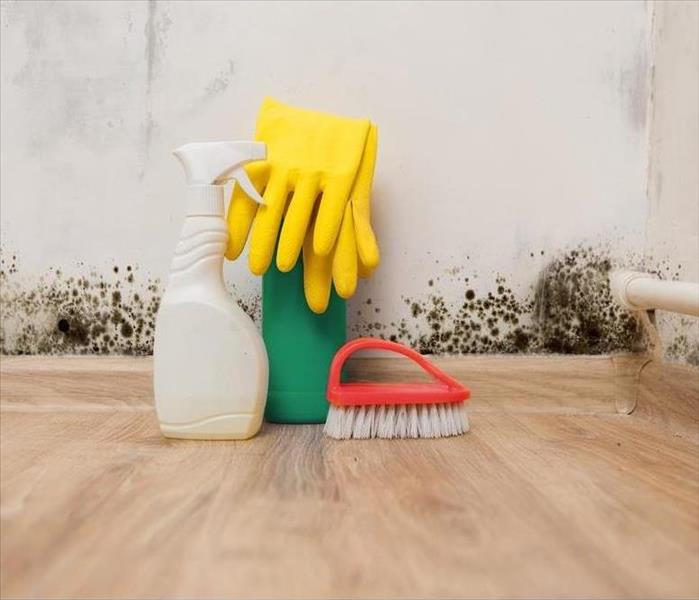 Household cleaning products are not designed to abate mold.
Household cleaning products are not designed to abate mold.
Scientific studies on mold are ongoing and at this time do not provide conclusive information on the potential effects on human health. There are a few things that are certain though; it grows at a rapid rate, it can permanently damage your home and it can be harmful to your health as well as anything living in your home.
Mold Treatments
At the first site of mold you may be tempted to clean the area using bleach or a similar product advertised as a "mold killer". Before you purchase anything, be sure you read the back of the label - you'll find that such products are often misleading.
- Bleach does kill mold, but not on all surfaces. Non-porous items like glass, tile, bathtubs and showers can be treated with bleach or similar products. While surfaces like drywall and hardwood will endure further damage from bleach.
- Spraying bleach on porous surfaces actually increases the growth rate of mold spores because excess moisture is provided.
- Bleach only removes the color from mold when used on porous surfaces, the roots or hyphae continue to grow.
- Chlorine bleach is extremely harmful to the integrity of surfaces. It breaks down the fibers of wood, which causes it to lose its strength. Metal almost immediately begins to corrode when combined with chlorine bleach.
Rather than potentially causing harm to yourself or your home, it is best to allow a professional to treat the affected areas in your home or business. SERVPRO of The Dutch Fork is equipped with trained technicians and antimicrobial agents that can contain, remove and begin the remediation process on your home or business.
Are Your Floors A Breeding Ground?
12/10/2018 (Permalink)
A flooded basement, burst pipes, a leaky toilet, these are just a few of the things we see on a weekly basis. The quantity of water in a damaged area can vary from centimeters to feet, but they all have one thing in common, and that is the possibility of mold growth.
Waterproof Flooring? Think Again.
Often homeowners become frustrated when the flooring they purchased must be removed after a water loss. The term "waterproof" is a huge selling point for the flooring industry. While it is great for spills and pets, it does not fully protect you from water damage should one occur. The joints that form together to create a water-tight bond do not form that same bond with walls, doorways and transition strips. Water gains access at these weak points and seeps underneath to the sub-floor. Leaving an affected area untreated creates the perfect conditions for a mold breeding ground. Mold thrives in damp, humid areas where moisture is abundant.
Just because you can't see it, does not mean it's not there! Don't take a chance when you find water damage, call SERVPRO of The Dutch Fork to protect your home or business.
Our Highly Trained Restoration Specialists can restore your Dutch Fork Home.
8/22/2018 (Permalink)
SERVPRO of The Dutch Fork is an IICRC firm. The Institute of Inspection, Cleaning and Restoration Certification (IICRC) creates the standards for the restoration industry and provides training and certification to restoration companies. IICRC Certified Firms have the right to display the IICRC Certified Logo.
IICRC Certified Firms must
• Present accurate information to consumers and conduct business with honesty and integrity.
• Require a technician on all jobs who has been formally trained and passed all required tests.
• Require a continuing education program to keep technicians up-to-date on the latest changes in the industry.
• Maintain liability insurance to protect all parties in the event of an accident.
• Maintain a written complaint policy and agree to Better Business Bureau or similar arbitration to resolve disputes, and accept the conclusions and recommendations of arbitration.
The IICRC Develops The Standards For The Restoration Industry
The IICRC has been the driving force in establishing the main industry standards and reference guides for professional carpet cleaning, water damage restoration and mold remediation. These IICRC standards take years to develop and require the coordination of experts in the field: manufacturers, industry organizations, insurance professionals, training schools, contractors, and public health professionals.
Every five years, the standards are reviewed and updated. The water damage restoration field changes rapidly with advancements in technology and science, and therefore the standards must evolve to keep pace.
About SERVPRO of The Dutch Fork
SERVPRO of The Dutch Fork specializes in the cleanup and restoration of residential and commercial property after a fire, smoke or water damage event. Our staff is highly trained in property damage restoration and we are an IICRC Certified Firm. We believe in continuous training: from initial and ongoing training at SERVPRO’s corporate training facility to regular IICRC-industry certification, rest assured our staff is equipped with the knowledge to restore your property.

 24/7 Emergency Service
24/7 Emergency Service


